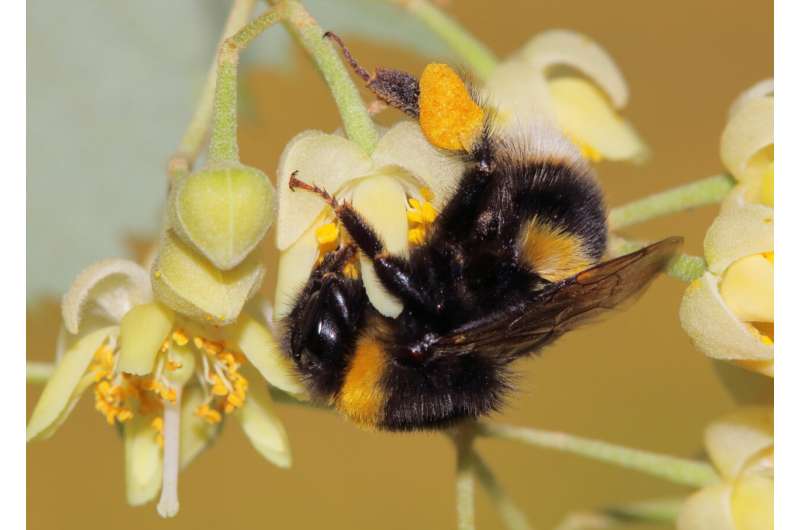
In a new paper published today in a special issue of The Royal Society, scientists and partners report on how bees protect themselves from parasites.
A team of researchers led by Dr. Hauke Koch and Professor Mark Brown from the University of London collected samples from linden and strawberry trees to determine how bees process the beneficial compounds within. The researchers found that two compounds found in the nectars of these species are activated by the bees and the gut microbiome.
The study wanted to find out how these elements and their anti-parasitic qualities can protect bees from the common gut parasites. The results of the experiments yielded promising results at a time when bees are facing increasing threat of decline from climate change, disease, and habitat loss due to agriculture and land use.
Pollination by animals is one of the most important species interactions, as plants offer a healthy reward to insects, birds, and small mammals in exchange for the transfer of pollen. This process facilitates the reproduction of many plants and it also supports global food production. Scientists are alarmed to see evidence of declines in pollinator abundance.
The dangers posed by parasites are one of the threats faced by pollinators. Bee parasites can be introduced and spread through global trade routes. Pesticide use affects the health of bees. Scientists are interested in the bumblebee gut parasites as they are known to threaten the survival and development of bumble colonies.
The lead author of the paper, Dr. Hauke Koch, says that Pollinators have diverse microbiomes in their guts and nest environments. The health of the pollinators can be improved by defending the communities of microorganisms. By better understanding the functional importance and contributions of individual members of the microbiome to different pollinators, we may in the future be able to better support their health.
For example, managed honeybee and bumblebee colonies can be supported through novel probiotics, or healthy microbiomes in wild pollinators can be maintained through a restriction in pesticides that negatively affect the microbiome and through the promotion of plants with nectar or pollen chemistry that stimulates healthy microbiomes.
The first compound analyzed by the team was found in the strawberry tree's honey. The evergreen shrubby tree is native to Ireland, Western Europe and the Mediterranean and is planted in parks and gardens in the UK. bumblebees like its flowers because of their high levels of pollen and its important food in the autumn. The honey produced by honeybees is sought after around the Mediterranean.

The compound was tested on C. bombi cultures grown in a lab as well as on buff-tailed bumblebee gynes, which are capable of reproduction. The researchers fed the bees a mixture of sugar syrup and pollen for two weeks, after which their feces were screened for parasites. The bees were given either sugar syrup or a drug. The compound was found to work against the C. bombi infections, but only after interacting with the microbiome.
The benefits of tiliaside to buff-tailed bumblebee workers were determined by the researchers. tiliaside was found to be activated by the bees. Both compounds have been put forward as evidence of the benefits that food and microbiomes hold for protecting and strengthening pollinator health at an individual and community level.
Understanding the drivers of pollinator health is critical to realizing how we can best support pollination services.
We now know that some flowers provide better nutrition for some species while others provide bees with a natural medicine, so we can select plants for restoring degraded landscapes or crop field margins that provide multiple and tailored benefits to enhancing their health from individual through to community level.
Pesticide use, the intensification of agriculture, and climate change are driving the decline of the pollinator. Scientists want to better understand the natural processes that influence and affect pollinator health. The effects of natural compounds and landscape structure are included in these processes.
After decades of evidence gathering, the impacts of human activities on pollinator health and decline through excessive pesticide use are now widely accepted.
We need to look for ways to sustain the diverse and healthy populations of insects. A better understanding of the natural processes that influence pollinator health can be used to develop many of these solutions. If we know how nutrition varies across the pollen of different species and which species provide the best food resources for the widest range of pollinating species, we can implement restoration programs such as field margin planting and ecological corridors with much better accuracy to the species of importance and with long-term benefits.
More information: Hauke Koch et al, Host and gut microbiome modulate the antiparasitic activity of nectar metabolites in a bumblebee pollinator, Philosophical Transactions of The Royal Society (2022). DOI: 10.1098/rstb.2021.0162 Journal information: Philosophical Transactions of the Royal Society Citation: Scientists discover how bees activate natural medicine against parasite infection during pollination (2022, May 1) retrieved 1 May 2022 from https://phys.org/news/2022-04-scientists-bees-natural-medicine-parasite.html This document is subject to copyright. Apart from any fair dealing for the purpose of private study or research, no part may be reproduced without the written permission. The content is provided for information purposes only.